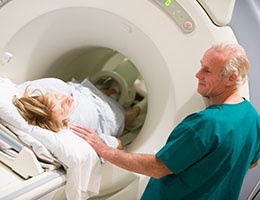 It is a routine practice for hospital-based practitioners to order radiology studies during the evaluation of sick or injured patients. The information gained from these imaging studies provides crucial information needed to make a diagnosis and guide treatment. As many as 50% of ED patients get a plain X-ray during their visit. It is well known that utilization of CT has greatly increased over the past decade. The end result is millions of patients in the ED and inpatient units who are transported to and from the radiology department.
It is a routine practice for hospital-based practitioners to order radiology studies during the evaluation of sick or injured patients. The information gained from these imaging studies provides crucial information needed to make a diagnosis and guide treatment. As many as 50% of ED patients get a plain X-ray during their visit. It is well known that utilization of CT has greatly increased over the past decade. The end result is millions of patients in the ED and inpatient units who are transported to and from the radiology department.
The appropriate utilization of radiology studies is a topic for another day. The focus today is the safety of the patient who leaves the ED or inpatient floor and goes to the radiology department. Consider the following cases.
Case #1
A 45-year-old woman presented to the ED with abdominal pain. She had taken some of her own narcotic pain medicine at home, and she was initially given 1 mg of hydromorphone per IV in the ED. An hour later, she was given an additional 2 mg of hydromorphone IV; minutes later, she was transported by an ED tech to radiology for an abdominal CT.
During the CT scan, the CT technician noted that the patient became very quiet and stopped breathing. A “code blue” was called, and the Code Team responded. The Code Team was comprised of the hospitalist, a respiratory therapist, and nurses, none of whom knew anything about the patient. She was not on a monitor. No part of the patient’s record, whether paper or electronic, was available in CT. The Code Team was not aware that she had received several narcotic doses just prior to the CT.
The patient was placed on monitors, resuscitated using bag-valve-mask ventilation, and transported back to the ED. Only then did the patient’s ED nurse and physician realize that their patient had suffered a respiratory arrest due to IV narcotic administration. The patient survived without deficits.
Case #2
A 78-year-old man came to the ED with a headache. He was on warfarin (Coumadin) for atrial fibrillation and had bumped his forehead during a fall that morning. His initial neuro exam showed no deficits. A head CT was ordered.
Ninety minutes later, the patient was taken to CT by an orderly. After he was moved to the CT table, he became unresponsive. A code was called, and he was resuscitated and mechanically ventilated. The subsequent head CT showed a large intracranial hemorrhage producing a mass effect. His INR was found to be elevated to 5.5. He died a few days later.
Discussion of Patient Safety in Radiology
These two cases represent high-risk patients who were sent to the CT scanner without a monitor or nurse. In these and similar events, the CT scanner has been referred to as the “Ring of Death,” where unstable patients are “sent to radiology to die.”
 Fortunately, most ED patients and inpatients who go to radiology are stable and have no complications. At the other end of the spectrum, patients who are on monitors or a ventilator usually have a nurse accompany them; policies and procedures may dictate which patients require a nurse to be with these patients. Some patients, however, are in the “gray zone” of stability and may deteriorate and even die during their trip to the CT scanner or radiology department.
Fortunately, most ED patients and inpatients who go to radiology are stable and have no complications. At the other end of the spectrum, patients who are on monitors or a ventilator usually have a nurse accompany them; policies and procedures may dictate which patients require a nurse to be with these patients. Some patients, however, are in the “gray zone” of stability and may deteriorate and even die during their trip to the CT scanner or radiology department.
Hospital-based practitioners should consider the following red flags when ordering an X-ray, CT, MRI, ultrasound, or nuclear study that requires that the patient leave the inpatient floor or the ED to go to radiology.
- Trauma Patients: Until their injuries are known, they may deteriorate due to injuries to the head, spine, chest, abdomen or pelvis.
- Chest Pain: These patients usually require monitoring for arrhythmias and hypoxia. If the X-ray cannot be done portably in the ED, their monitoring should continue in radiology and they should be accompanied by a nurse.
- Altered Mental Status: Until the diagnosis is known and the patient is stable, patients with confusion and altered mental status may not be able to protect their airway, or they may deteriorate due to their underlying condition (stroke, hemorrhage, toxic, metabolic, infectious, trauma, etc.).
- Narcotized or Sedated Patients: Patients who have just been given narcotics, particularly by the IV route, are at risk for respiratory depression. If they are very drowsy or have just received IV narcotics or conscious sedation, either wait until they are stable or send them to X-ray on a monitor with a nurse.
- Abdominal Pain in Patients over Age 65: They may have an abdominal aortic aneurysm (AAA) that could cause them to deteriorate if it leaks or ruptures.
- Unstable Vital Signs: We take “vital” signs for a reason. Abnormal vital signs may include hypotension, severe hypertension, bradycardia, tachycardia, arrhythmias and respiratory distress, which are all clues that the patient is unstable and might crash. These patients need continuous monitoring and a nurse to assess them, especially if they leave the ED or another inpatient unit.
Protect any patient who has one of the “red flags” or any other condition that could cause them to deteriorate when they leave your floor or ED. Be familiar with and follow established policies and protocols, and ask yourself if they should be monitored and accompanied by a nurse. Err on the side of safety.

